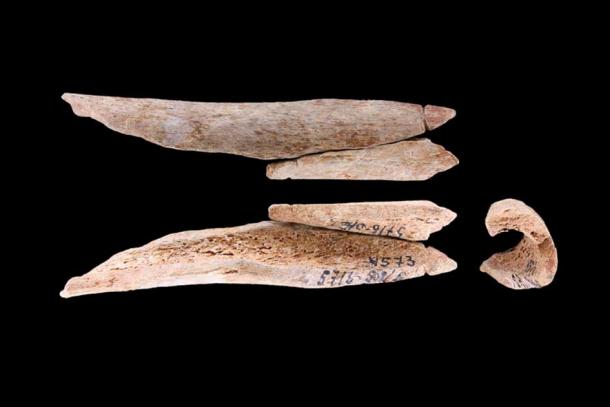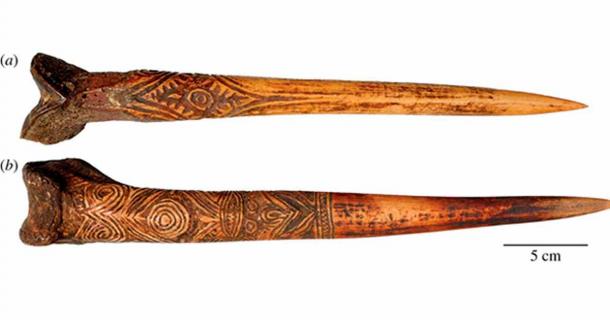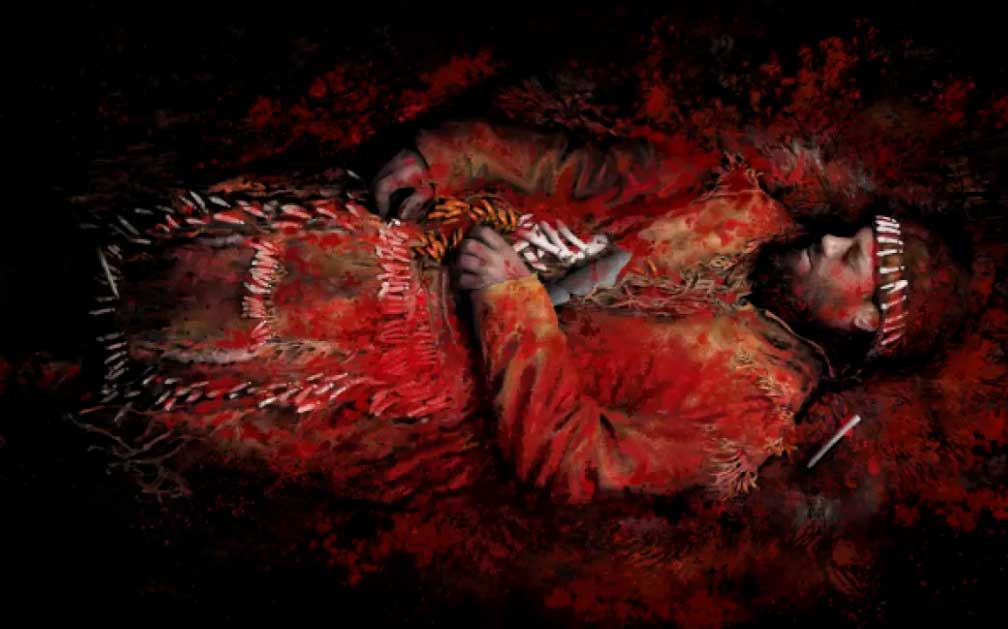Finnish Study Reveals Human Bones Were Used to Make Jewelry in 6,000 BC
During the Late Stone Age, our prehistoric ancestors regularly constructed and presumably wore pendants covered with symbolic images. These pendants were often made out of animal bones and teeth, but revolutionary new research reveals that human bones were also used to make this popular form of ancient jewelry.
This research recently published in the Journal of Archaeological Science: Reports was carried out by a team of Finnish and Russian archaeologists and anthropologists, the former from the University of Helsinki and the latter from the Russian Academy of Sciences. These experts re-examined prehistoric pendants that were originally recovered and analyzed more than eight decades ago. Some of these items had been excavated from an archaeological layer that was 8,200 years ago, which gave the scientists the opportunity to look more deeply into the culture of a truly remote era.
The bones used to make the ancient pendants had previously been identified as exclusively coming from animals. But using modern technology to examine the artifacts more closely, the researchers discovered that both animal and human bones were used to make this near-Arctic bone jewelry. Moreover, human bones were used quite frequently!

Though the bulk of the bone jewelry from the Russian Yuzhniy Oleniy Ostrov Island site from the Late Stone Age was animal bone, modern science is revealing that human bones were frequently used. (Journal of Archaeological Science: Reports)
A Stunning Hidden Bone Jewelry Secret Found In Russia
In a series of excavations that took place in the 1930s, archaeologists uncovered human remains and burial objects from 177 graves on Yuzhniy Oleniy Ostrov Island in Lake Onega in northwestern Russia. Included in the grave goods were many animal tooth and bone pendants, decorated with images of the Eurasian elk, the beaver, and the brown bear. Miniature sculptures of the same animals were also found, making it clear these and other animals were important to the Late Stone Age (Neolithic Period) culture that occupied the area around Lake Onega.
While the bones and teeth used to make the pendants could be linked to specific species of animals in many cases, some of the bones used to make the pendants could not be identified. It was assumed at the time they came from an undiscovered animal species, and the matter was left there.
- How to Read the Symbolism in Aboriginal Art
- Hints of Ancient Symbolic Culture are Revealed in Indonesian Ice Age Art and Jewelry
But things changed when the pendant collection recovered in Russia in the 1930s was obtained by the Animals Make Identities research project at the University of Helsinki. This broad-based, ongoing study is being led by University of Helsinki archaeology professor Kristiina Mannermae, and its purpose is to further explore the meaning of animals and animal symbolism in Late Stone Age / Early Neolithic Period cultures.
As a part of their research, the project scientists sent the bone pendants to the BioArCh research facility at the University of York in the United Kingdom. Researchers there used mass spectrometry technology to analyze proteins samples of the bones used to make the jewelry, which allowed for a precise identification of the species from which the bones came.
When the results of these tests were returned, the researchers were not surprised to discover that most of the samples came from elk bones or from those of an ancient bovine creature. But they were shocked to learn that 12 of 37 samples tested were identified as human bones.
Archaeologists have found jewelry made from human remains before including teeth and femur bones. But never in this part of the world, and the fact such jewelry could be dated to 6000 BC or earlier made the discovery even more extraordinary.

Bone daggers of the Sepik watershed, New Guinea. (a) Human bone dagger attributed to the Upper Sepik River. (b) Cassowary bone dagger attributed to the Abelam people. (Hood Museum of Art, Dartmouth College)
Why Did the Ancients Use Human Bones to Make Things?
Notably, the human pendants were found in just three graves, one of which contained the skeletal remains of two people.
This raises the possibility that only individuals of a certain status, occupation, or life history were entitled to use human bones to make pendants, and that most people were only allowed to use animal bones and teeth to make these treasured objects. It’s also possible that people were free to choose any material they wanted to make their pendants, and that the majority preferred to work with animal bones.
On those occasions when human bones were used, they may have been taken from loved ones who had passed away, signifying a type of ancestor worship. Still another possibility is that the human bone pendants were carved from the remains of individuals who were highly accomplished or respected within the Lake Onega hunter-gatherer community as a whole and that only those who’d achieved a certain status would be honored by having their bones used to make symbolic jewelry.
One unsettling possibility is that the use of human bones to make jewelry could have been associated with cannibalism. There is evidence in the archaeological record to suggest that cannibalism was practiced in the Stone Age in some parts of the world.
As of now, it is impossible to determine if cannibalism was practiced by the ancient residents of the Lake Onega region.
“The surface of the bone pendants we investigated is so worn out that you cannot make out any potential cut marks, which means we have no reason to suspect cannibalism on the basis of the discoveries in Yuzhniy Oleniy Ostrov,” Mannermaa explained in a University of Helsinki press release.

A total of 90 elk teeth were placed next to the hips and thighs of one female skeleton from the same site, possibly attached to a garment resembling an apron. Red ochre had been sprinkled on top of the deceased. This drawing shows what the Yuzhniy Oleniy Ostrov woman may have looked like when she died. (Tom Bjorklund / University of Helsinki)
The Difficult Challenge of Solving Prehistoric Puzzles
Little is known about the cultural or metaphysical belief systems of the ancient Lake Onega pendant makers, making it difficult to explain the real purpose of their actions.
It isn’t known if the pendants were worn all the time, only on special occasions, or not worn at all and only used as burial goods (as offerings to the gods, perhaps?). The researchers find it noteworthy that the bone pendants made from animal and human bones look identical, and that pendants of both types were buried together.
- 8,000-Year-Old Elk Teeth “Dancing Rattlers” Are Recreated
- Human Bone Daggers in New Guinea were Used to Strike the Fatal Wound
“The fact that the use of human bones was not emphasized in any way and that the objects are indistinguishable and similar to objects made of animal bones may indicate the intertwining of animals and humans in the Stone Age worldview,” Mannermaa said. “Using animal and human bones together in the same ornament or clothing may have symbolized the ability of humans to transform into animals in their minds, in addition to which they believed that animals were capable of taking human form. We know that such blurring of forms and boundaries has been and still is part of the worldview of indigenous peoples.”
There will inevitably be much speculation about the reasons why prehistoric residents of the lands of modern-day Russia were making valued jewelry pieces from human remains. Unfortunately, archaeologists and ancient historians have no choice but to speculate about the motivations of Stone Age peoples, who left behind a bounty of artifacts but no written records to help others interpret them.
Top image: Grave 69, of an adult male, on the island of Yuzhniy Oleniy Ostrov, who had human bone jewelry in his grave. Human and animal bone pendants were found together with an elk tooth pendant. Source: Tom Björklund / University of Helsinki
By Nathan Falde




















Comments
I lean to the rational. After all, they survived, ...until the calamity. Not like today, where lemmings are jumping in mass.
Nobody gets paid to tell the truth.
Cannibalism, of course, can fit both ancestor worship and ritual domination.
There are a number of possibilities, including convenience or ritual. Ritual use could take the form of ancestor worship, or shamanistic interweaving of human and animal spirits. But it could also be the result of domination, a type of skull on a spike event common throughout history. Such ritual domination still happens today in high society with proudly displayed products made from human leather, including from innocent children. Of course, to mention such activity is shocking, for we like to think human society has moved on from such atrocities, but people don't change that much. And as we don't change that much, most prefer to not to dwell on such matters at all, which does nothing for wiping them out. To live in ignorance is to live in the past, while pretending the opposite to be true.
From the article, “This raises the possibility that only individuals of a certain status, occupation, or life history were entitled to use human bones to make pendants, and that most people were only allowed to use animal bones and teeth to make these treasured objects.“
Anything’s possible. But next to metal, femur bone, maybe the one you just found, would make the best daggers. As for trinkets, like today, could be a fun thing for the kids to work on, down in their caves, during the long winters. Give it to Daddy, when he comes back from a successful hunt.
Nobody gets paid to tell the truth.